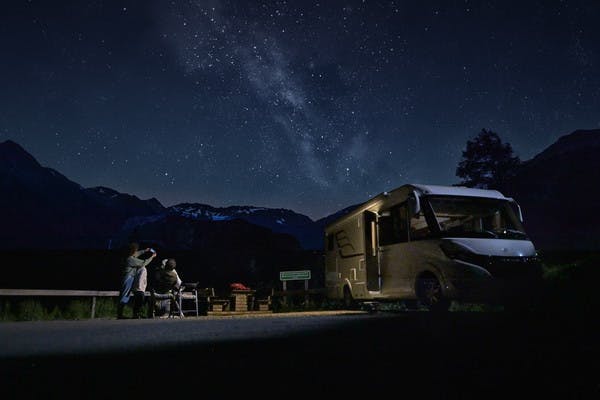Seeking Darkness
A century ago, people could look up from almost any vantage point and see a completely star-studded sky. But with the growth of cities and increased use of artificial light, these purely starry skies are harder to come by. However, my family and I make a point to study dark sky maps and take RV trips specifically to see these places. DarkSiteFinder is one of my favorite resources to find the best starry skies—it’s a color-coded map that illustrates light pollution using the nine-class Bortle Scale. The best locations for stargazing are a Bortle 1, while the details in the sky diminish with each increment, ending with a heavily light-polluted Bortle 9.
There are a number of state and national parks that boast about their dark skies, but with these dark skies often comes remoteness and isolation. It’s important when visiting dark parks to take extra care in planning when and how to get there. Be sure to consider the proximity to gas stations and any additional steps to ensure an adequate supply of water and power for the duration of your visit. It doesn’t hurt to have extra of both. Some parks also have primitive access, which usually means you can access the park grounds via a remote dirt road. If you do decide to travel on unpaved or unfamiliar roads with your RV, it’s always a good idea to compare these routes with a trucker’s atlas to help ensure a safe arrival.
The Starry Night Campsite
When selecting a campsite for stargazing, there are some key factors to take into consideration. Wide, unobstructed views are ideal, so try to select a site with few trees and a clear view of the horizon. Additionally, the less light you produce, the better. Try to keep campsite lights to a minimum to allow your eyes to adjust and become more sensitive to the stars above. It’s also courteous to other campers to keep your personal light pollution low.
That being said, a little bit of light is necessary for safe star viewing—you don’t want to trip or fall on something as you make your way through the dark! To help adjust your eyesight, invest in a red flashlight or a headlamp with a red light. The red light helps preserve night vision and decrease the overall light signature in low-light situations.









